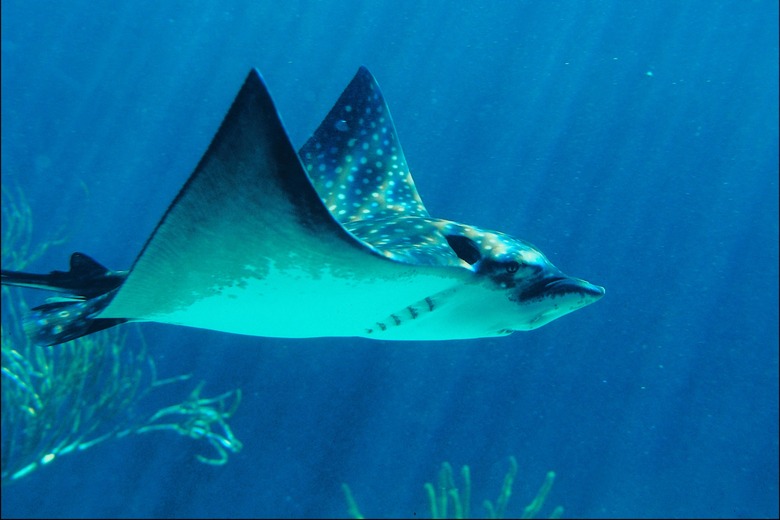Types Of Stingray Fish
Stingrays are cartilaginous fish (having cartilage instead of bones) that live in temperate and tropical marine and freshwater habitats throughout the world. They share this cartilaginous body structure with their close relatives the sharks. Although they lack the sharp teeth of sharks, stingrays have venomous barbs on their tails. Unprovoked attacks on humans by "stingarees" (another name for stingray) are extremely rare, and waders and swimmers can minimize the chance of an injury by shuffling their feet on the seafloor to alert rays of their presence.
Types of Stingrays: Eagle Rays
Types of Stingrays: Eagle Rays
Eagle rays belong to the Myliobatidae family of stingray fish. In contrast to the bottom-dwelling habits of many stingray species, eagle rays actively swim the open ocean (the pelagic zone) and are well known for leaping out of the water. These rays usually live in warm, tropical waters such as the Indian Ocean and Caribbean Sea, though the common eagle ray cruises temperate seas of the North Atlantic. It and the spotted eagle ray rank among the most widely distributed of the family. Other types of stingrays in Myliobatidae include the banded, ornate, mottled and bat eagle rays.
Sixgill Stingray
Sixgill Stingray
The sixgill stingray is the only species in the Hexatrygonidae family of stingrays. As its name suggests, the sixgill stingray boasts six pairs of gill openings. Other distinguishing physical characteristics include its triangular snout and gill arches.
Round Rays
Round Rays
Round rays constitute the Urotrygonidae stingray family. These stingrays have a round pectoral disk, a slender tail and no dorsal fins. Most round rays live in the warm waters of the Caribbean Sea and along the coastlines of North and South America. The round stingray ranks among the most abundant types of stingrays within its range. Urotrygonidae stingray species also include the Chilean round, Haller's round and yellow stingray.
Deepwater Stingray
Deepwater Stingray
The only member of the Plesiobatidae family of stingrays is the deepwater stingray. Also known as the giant stingaree, this stingray lives at depths of over 2,200 feet below the water's surface. The deepwater stingray's pectoral disc has an oval shape and its tail ends in a leaf-shaped caudal fin.
Butterfly Rays
Butterfly Rays
The Gymnuridae family of stingrays includes all butterfly ray species. Butterfly rays have flattened bodies and shorter tails than other types of stingrays. Some species grow quite large: The spiny butterfly ray, for example, may possibly reach 13 feet across. Smooth, Australian, California, backwater and zonetail butterfly rays are other Gymnuridae species.
Whiptail Stingrays
Whiptail Stingrays
Whiptail stingrays get their names from their whip-shaped tails, which include venemous barbs at their tips. Whiptail rays belong to the stingray family Dasyatidae. While most whiptails dwell in saltwater environments, some species inhabit rivers, including the giant freshwater stingray of Southeast Asia, one of the heftiest freshwater fish in the world. Other whiptail stingray species include the roughtail stingray, blue stingray, sharpnose stingray, pelagic ray, porcupine ray and painted maskray.
References
- University of Florida – Florida Museum of Natural History: Spotted Eagle Ray
- University of Michigan Museum of Zoology — Animal Diversity Web: Sixgill Stingray
- Aquarium of the Pacific: Round Stingray
- University of Florida – Florida Museum of Natural History: Spiny Butterfly Ray
- University of Michigan Museum of Zoology — Animal Diversity Web: Family Dasyatidae
Cite This Article
MLA
Davis, Skip. "Types Of Stingray Fish" sciencing.com, https://www.sciencing.com/types-stingray-fish-8729037/. 20 July 2018.
APA
Davis, Skip. (2018, July 20). Types Of Stingray Fish. sciencing.com. Retrieved from https://www.sciencing.com/types-stingray-fish-8729037/
Chicago
Davis, Skip. Types Of Stingray Fish last modified March 24, 2022. https://www.sciencing.com/types-stingray-fish-8729037/
